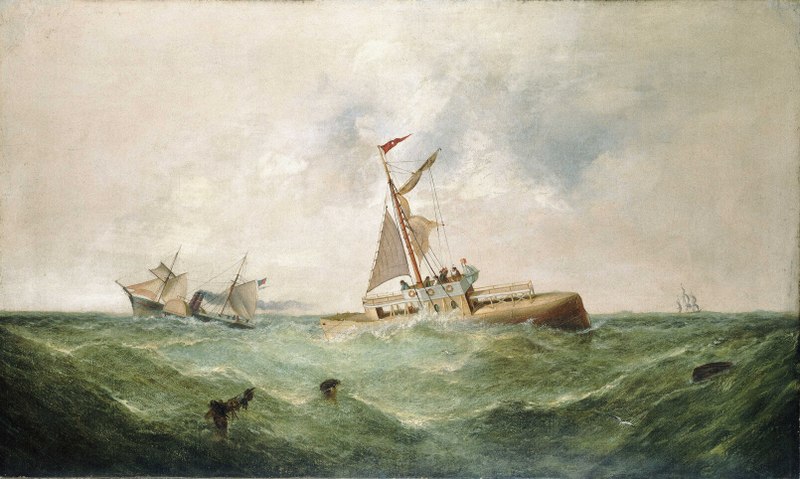The scores of George Crumb’s Makrokosmos piano suite take unusual forms: a circle, a cross, a spiral, a peace sign.
Each is handwritten.
The scores of George Crumb’s Makrokosmos piano suite take unusual forms: a circle, a cross, a spiral, a peace sign.
Each is handwritten.
This is pretty: If you choose n > 1 equally spaced points on a unit circle and connect one of them to each of the others, the product of the lengths of these chords equals n.
(Andre P. Mazzoleni and Samuel Shan-Pu Shen, “The Product of Chord Lengths of a Circle,” Mathematics Magazine 68:1 [February 1995], 59-60.)
(Demonstration by Jay Warendorff.)
Written by Albert Einstein at the invitation of a German magazine, 1921:
What Artistic and Scientific Experience Have in Common
Where the world ceases to be the scene of our personal hopes and wishes, where we face it as free beings admiring, asking, and observing, there we enter the realm of Art and Science. If what is seen and experienced is portrayed in the language of logic, we are engaged in science. If it is communicated through forms whose connections are not accessible to the conscious mind but are recognized intuitively as meaningful, then we are engaged in art. Common to both is the loving devotion to that which transcends personal concerns and volition.
(From Helen Dukas and Banesh Hoffmann, eds., Albert Einstein, the Human Side: New Glimpses From His Archives, 1979.)
A jailer will send each of a group of n prisoners alone into a certain room. Each prisoner will visit the room infinitely often, but the order of the visits will be determined arbitrarily by the jailer. The prisoners can confer in advance, but once the visits have commenced they can communicate with one another only by means of a light in the room, which they can turn on or off. How can they ensure that some prisoner will eventually be able to determine that everyone has visited the room?
In 1924 architect Frederick Kiesler proposed a house fashioned as a continuous shell rather than an assembly of columns and beams:
The house is not a dome, but an enclosure which rises along the floor uninterrupted into walls and ceilings. Thus the safety of the house does not depend on underground footings but on a strict coordination of all enclosures of the house into one structural unit. Even the window areas are not standardized in size or shape, but are, rather, large and varied in their transparency and translucency, and form part of the continuous flow of the shell.
Storage space is provided between double shells in the walls, radiant heating is built into the floor, and there are no separate bathrooms, as bathing is done in the individual living quarters.
“While the concept of the house does not advocate a ‘return to nature’, it certainly does encourage a more natural way of living, and a greater independence from our constantly increasing automative way of life.”
(Via Ulrich Conrads, The Architecture of Fantasy: Utopian Building and Planning in Modern Times, 1962.)
“Suppose a contradiction were to be found in the axioms of set theory. Do you seriously believe that that bridge would fall down?” — Frank Ramsey, to Wittgenstein
“Does anyone believe that the difference between the Lebesgue and Riemann integrals can have physical significance, and that whether, say, an airplane would or would not fly could depend on this difference? If such were claimed, I should not care to fly in that plane.” — Richard W. Hamming

In the 19th century, France, England, and the United States each set out to bring home an Egyptian obelisk. But each obelisk weighed hundreds of tons, and the techniques of moving them had long been forgotten. In this week’s episode of the Futility Closet podcast we’ll follow the struggles of each nation to transport these massive monoliths using the technology of the 1800s.
We’ll also go on an Australian quest and puzzle over a cooling fire.
A French Prisoner in Norman Cross Barracks, had recourse to the following stratagem to obtain his liberty:–He made himself a complete uniform of the Hertfordshire Militia, and a wooden gun, stained, surmounted by a tin bayonet. Thus equipped, he mixed with the guard, (consisting of men from the Hertford Regiment,) and when they were ordered to march out, having been relieved, Monsieur fell in and marched out too. Thus far he was fortunate, but when arrived at the guard-room, lo! what befel him. His new comrades ranged their muskets on the rack, and he endeavoured to follow their example; but as his wooden piece was unfortunately a few inches too long, he was unable to place it properly. This was observed, and the unfortunate captive obliged to forego the hopes of that liberty for which he had so anxiously and so ingeniously laboured.
— The Soldier’s Companion; or, Martial Recorder, 1824
The first escape from [Dartmoor Prison] took place five days after the first draft arrived. Sevegran, a naval surgeon, and Auvray, a naval officer, having observed that a guard of fifty men marched into the prison every evening to assist in getting the prisoners into their respective halls if required, made themselves glengarries and overcoats, and strips of tin looking like bayonets at a distance, and fell in at the rear of the detachment as it marched out. Favoured by the rain which was falling heavily at the time they passed all the gates unquestioned, and as the company wheeled towards the barracks, they left it, and went on through the village towards Plymouth. Speaking English fluently and being well provided with money, they had no difficulty in booking seats for London on the coach.
— Basil Thomson, The Story of Dartmoor Prison, 1907
Excerpts from the Evil Overlord List, compiled in 1990 by the FidoNet Science Fiction and Fandom email echo:
If I were the Evil Overlord …